
AP Physics Multiple Choice Practice – Magnetism and Electromagnetism
SECTION A – Magnetostatics
 1. Four infinitely long wires are
arranged as shown in the accompanying figure end–on view. All four wires are
perpendicular to the plane of the page and have the same magnitude of current
I. The conventional current in the wire in the upper right–hand corner is
directed into the plane of the page. The other conventional currents are out
of the plan of the page. Point P is a distance a from all four wires. What is
the total magnetic field at point P?
1. Four infinitely long wires are
arranged as shown in the accompanying figure end–on view. All four wires are
perpendicular to the plane of the page and have the same magnitude of current
I. The conventional current in the wire in the upper right–hand corner is
directed into the plane of the page. The other conventional currents are out
of the plan of the page. Point P is a distance a from all four wires. What is
the total magnetic field at point P?
A) ![]()
![]() toward the upper left hand corner
toward the upper left hand corner
B) ![]()
![]() toward the lower left hand corner
toward the lower left hand corner
C) ![]()
![]() toward the upper left hand corner
toward the upper left hand corner
D) ![]()
![]() toward the lower left hand corner
toward the lower left hand corner
E) 0
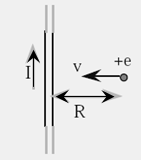
2. The conventional current I in a long straight wire flows in the upward direction as shown in the figure. (Electron flow is downward.) At the instant a proton of charge +e is a distance R from the wire and heading directly toward it, the force on the proton is:
A) ![]()
![]() toward the wire
toward the wire
B) ![]()
![]() upward (in the same direction as
I)
upward (in the same direction as
I)
C) ![]()
![]() downward (in the opposite
direction as I)
downward (in the opposite
direction as I)
D) ![]()
![]() upward (in the same direction as
I)
upward (in the same direction as
I)
E) ![]()
![]() downward (in the opposite
direction as I)
downward (in the opposite
direction as I)
 3. A charged particle with constant
speed enters a uniform magnetic field whose direction is perpendicular to the
particles velocity. The particle will:
3. A charged particle with constant
speed enters a uniform magnetic field whose direction is perpendicular to the
particles velocity. The particle will:
A) Speed up B) Slow down C) Experience no change in velocity
D) Follow a parabolic arc E) Follow a circular arc
4. A long straight wire conductor is placed below a compass as shown in the top view figure. When a large conventional current flows in the conductor as shown, the N pole of the compass:
A) remains undeflected B)
points to the south
C) points to the west D) points to the east E) has its
polarity reversed
5. A proton of mass M and kinetic energy K passes undeflected through a region with electric and magnetic fields perpendicular to each other. The electric field has magnitude E. The magnitude of the magnetic field B is
![]()
 6. An electric current flows through a
horizontal wire as shown. Which option best represents the direction of the
magnetic field at point P
6. An electric current flows through a
horizontal wire as shown. Which option best represents the direction of the
magnetic field at point P
A) into the page
B) out of the page
C) to the right of the page
D) toward the top of the page
E) toward the bottom of the page
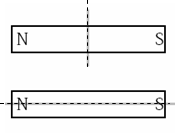
7. Two bar magnets are to be cut in half along the dotted lines shown. None of the pieces are rotated. After the cut:
A) None of the halves will attract
any other
B) The two halves of each magnet will attract each other
C) The two halves of each magnet will repel each other
D) The two halves of the top magnet will repel, the two halves of the bottom
magnet will attract
E) The two halves of the top magnet will attract, the two halves of the bottom
magnet will repel
8. An ion with charge q, mass m, and speed V enters a magnetic field B and is deflected into a path with a radius of curvature R. If a second ion has speed 2V, while m, q, and B are unchanged, what will be the radius of the second ion’s path?
A) 4R B) 2R C) R D) R/2 E) R/4

9. A wire moves through a magnetic field directed into the page. The wire experiences an induced charge separation as shown. Which way is the wire moving?
A) to the right D)
toward the top of the page
B) to the left E) toward the bottom of the page
C) out of the page
10. A charged particle with constant velocity enters a uniform magnetic field whose direction is parallel to the particle’s velocity. The particle will
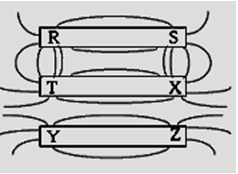 A) speed up
A) speed up
B) slow down
C) experience no change in velocity
D) follow a parabolic arc
E) follow a circular arc
11. The diagram to the right depicts iron
filings sprinkled around three permanent magnets. Pole R is the same pole as
A) T and Y
B) T and Z
C) X and Y
D) X and Z
E) S, T, and Z
12. If conventional electric current flows from left to right in a wire as shown, what is the direction of the magnetic field at point P?

A) towards
the top of the paper D) out of the paper
B) towards the bottom of the paper E) to the right
C) into the paper
13. Two light wires are hung vertically.
With electrical current in both wires directed upwards
A) the wires will experience a force of attraction
B) the wires will experience a force of repulsion
C) the force on the right hand wire will cancel the force on the left hand wire
D) both wires will experience a torque until they are at right angles to each
other
E) none of the above
![]() 14. A wire moves with a velocity v
through a magnetic field and experiences an induced charge separation as
shown. What is the direction of the magnetic field?
14. A wire moves with a velocity v
through a magnetic field and experiences an induced charge separation as
shown. What is the direction of the magnetic field?
 A) into the page
A) into the page
B) towards the bottom of the page
C) towards the right
D) out of the page
E) towards the top of the page
15. A positively charged particle moves to the right. It enters a region of space in which there is an electric field directed up the plane of the paper as shown. In which direction does the magnetic field have to point in this region so that the particle maintains a constant velocity?
A) into the plane of the page
B) out of the plane of the page
C) to the right
D) to the left
E) up the plane of the page
 16. A compass is placed near a coil of
wire. A conventional electrical current is then run through the coil from left
to right as shown. This will cause the North pole of the compass to:
16. A compass is placed near a coil of
wire. A conventional electrical current is then run through the coil from left
to right as shown. This will cause the North pole of the compass to:
A) point toward the left
B) point toward the right
C) point toward the bottom of the paper
D) not move since the magnetic field of the coil is into the paper
E) not move since the magnetic field of the coil is out of the paper
 17. Two parallel wires are carrying different
electric current in the same direction as shown. How does the magnitude of the
force of A from B compare to the force of B from A
17. Two parallel wires are carrying different
electric current in the same direction as shown. How does the magnitude of the
force of A from B compare to the force of B from A
A) FB on A = 4 FA on B
B) FB on A = ¼ FA on B
C) FB on A = 2 FA on B
D) FB on A = ½ FA on B
E) FB on A = FA on B
18. A positively charged particle of mass
M is at rest on a table. A non–zero electric field E is directed into the
plane of the table. A non–zero magnetic field B is directed out of the plane
of the table. What is true about the magnitude of the electric force on the
particle FE compared to the magnetic force on the particle FB?
A) FE > FB B)
FE < FB C) FE
= FB
D) It cannot be determined without knowing the exact value of the charge of the
particle
E) The relative sizes of the electric and magnetic fields are needed to answer
this question

19. A positive electric charge of
negligible weight is released from rest between the poles of a horseshoe magnet
as shown. What would be the direction of the acceleration of the charge caused
by the magnetic field?
A) towards the north pole D) downwards
B) towards the south pole E) none of the above
C) upwards
20. Two very long current–carrying wires are shown end on in the figure. The wire on the left has a 4A current going into the plane of the paper and the wire on the right has a 3A current coming out of the paper. Disregarding the case of x à ∞, in which region(s) could the magnetic field from these two wires add to zero on the x–axis.

A) Region I only B) Region II only C) Region III only D) Regions I
and III only E) none
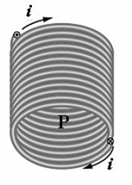
21. The magnetic field line passing
through point P inside the solenoid is directed
A) to the right
B) to the left
C) downward toward the bottom of the page
D) upward toward the top of the page
E) in no direction since the magnetic field is zero
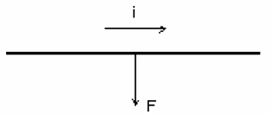 22. The diagram below shows a straight
wire carrying a current i in a uniform magnetic field. An arrow indicates the
magnetic force F on the wire. Of the following possibilities, the direction of
the magnetic field must be
22. The diagram below shows a straight
wire carrying a current i in a uniform magnetic field. An arrow indicates the
magnetic force F on the wire. Of the following possibilities, the direction of
the magnetic field must be
A) out of the page
B) into the page
C) to the right
D) up the plane of the page
E) down the plane of the page
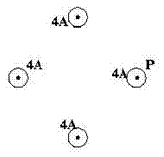
23. For the four identical current-carrying wires shown (with conventional current coming out of the plane of the page), the wire on the right is labeled P. What is the direction of the magnetic force on the wire labeled P from the other wires?
A) To the left
B) To the right
C) Up the plane of the page
D) Down the plane of the page
E) There is no force.
24. A wire has a conventional current I directed to the right. At the instant shown in the figure, an
electron has a velocity directed to the left. The magnetic force on the electron at this instant is

A) zero.
B) directed out of the plane of the page.
C) directed into the plane of the page.
D) directed toward the top of the page.
E) directed toward the bottom of the page.
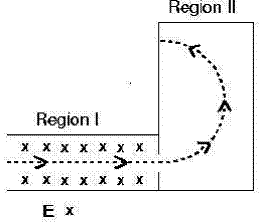 25. An electron moves in the plane of the
page through two regions of space along the dotted-line trajectory shown in the
figure. There is a uniform electric field in Region I directed into the plane
of the page (as shown). There is no electric field in Region II. What is a necessary
direction of the magnetic field in regions I and II? Ignore gravitational forces.
25. An electron moves in the plane of the
page through two regions of space along the dotted-line trajectory shown in the
figure. There is a uniform electric field in Region I directed into the plane
of the page (as shown). There is no electric field in Region II. What is a necessary
direction of the magnetic field in regions I and II? Ignore gravitational forces.
|
|
Region I |
Region II |
|
A) |
Down on the page |
Up on the page |
|
B) |
Up on the page |
Into the page |
|
C) |
Up on the page |
Out of the page |
|
D) |
Down on the page |
Out of the page |
|
E) |
Into the page |
Up on the page |
26. A proton moves straight up the plane of this page into a region that has a magnetic field directed
to the right. If the particle is undeflected as it passes through this region, in what direction must
there be a component of electric field? Ignore gravity.
A) To the left B) Into the page C) Out of the page D) Down the page E) To the right
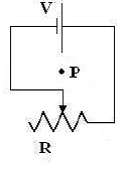 27. For the figure shown, the variable
resistance in the circuit is increased at a constant rate. What is the
direction of the magnetic field at the point P at the center of the circuit
27. For the figure shown, the variable
resistance in the circuit is increased at a constant rate. What is the
direction of the magnetic field at the point P at the center of the circuit
|
|
Magnetic Field at P |
|
A) |
Into the page |
|
B) |
Out of the page |
|
C) |
To the left |
|
D) |
To the right |
|
E) |
There is no field |
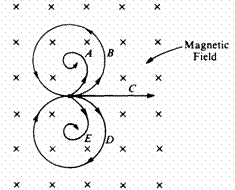
28. Which of the paths represents the path
of an electron traveling without any loss of energy through a uniform magnetic
field directed into the page?
(A) A (B) B (C) C (D) D (E) E
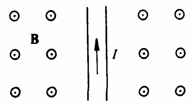 29. A wire in the plane of the page
carries a current directed toward the top of the page as shown. If the wire is
located in a uniform magnetic field B directed out of the page, the force on
the wire resulting from the magnetic field is
29. A wire in the plane of the page
carries a current directed toward the top of the page as shown. If the wire is
located in a uniform magnetic field B directed out of the page, the force on
the wire resulting from the magnetic field is
(A) directed into the page (D) directed to the left
(B) directed out of the page (E) zero
(C) directed to the right
 30. The direction of the magnetic field at
point R caused by the current I in the wire shown is
30. The direction of the magnetic field at
point R caused by the current I in the wire shown is
(A) to the left (B) to
the right (C) toward the wire
(D) into the page (E) out of the page
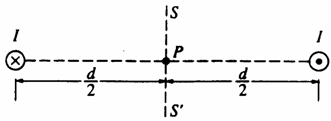 31. Two long, parallel wires are separated
by a distance d, as shown. One wire carries a steady current I into the plane
of the page while the other wire carries a steady current I out of the page.
At what points in the plane of the page and outside the wires, besides points
at infinity, is the magnetic field due to the currents zero?
31. Two long, parallel wires are separated
by a distance d, as shown. One wire carries a steady current I into the plane
of the page while the other wire carries a steady current I out of the page.
At what points in the plane of the page and outside the wires, besides points
at infinity, is the magnetic field due to the currents zero?
(A) Only at point P
(B) At all points on the line SS'
(C) At all points on the line connecting the two wires
(D) At all points on a circle of radius 2d centered on point P
(E) At no points
32. An electron is in a uniform magnetic field B that is directed out of the plane of the page, as shown. When the electron is moving in the plane of the page in the direction indicated by the arrow, the force on the electron is directed
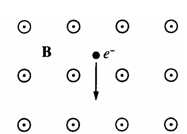 (A) toward the right
(A) toward the right
(B) out of the page
(C) into the page
(D) toward the top of the page
(E) toward the bottom of the page
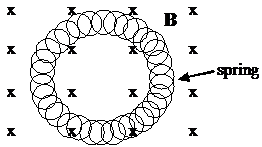 33. A metal spring has its ends attached so that it forms a circle. It
is placed in a uniform magnetic field, as shown. Which of the following will
not cause a current to be induced in the spring?
33. A metal spring has its ends attached so that it forms a circle. It
is placed in a uniform magnetic field, as shown. Which of the following will
not cause a current to be induced in the spring?
(A) Changing the magnitude of the magnetic field
(B) Increasing the diameter of the circle by stretching the spring
(C) Rotating the spring about a diameter
(D) Moving the spring
parallel to the
magnetic field
(E) Moving the spring in and out
of the
magnetic field
A magnetic field of 0.1T forces a proton beam of 1.5 mA to move in a circle of radius 0.1 m. The plane of the circle is perpendicular to the magnetic field.
34. Of the following, which is the best estimate of the work done by the magnetic field on the protons during one complete orbit of the circle?
(A) 0 J (B) 10-22 J (C) 10-5 J (D) 102 J (E) 1020 J
35. Of the following, which is the best estimate of the speed of a proton in the beam as it moves in the circle?
(A) 10-2 m/s (B) 103 m/s (C) 106 m/s (D) 108 m/s (E) 1015 m/s
36. Two parallel wires, each carrying a current I, repel each other with a force F. If both currents are doubled, the force of repulsion is
(A) 2F (B) 2√2 F (C) 4F (C) 4√2 F (E) 8F
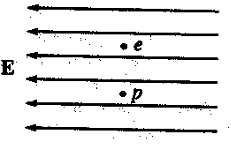 37. An electron e and a proton p are
simultaneously released from rest in a uniform electric field E, as shown.
Assume that the particles are sufficiently far apart so that the only force
acting on each particle after it is released is that due to the electric
field. At a later time when the particles are still in the field, the electron
and the proton will have the same
37. An electron e and a proton p are
simultaneously released from rest in a uniform electric field E, as shown.
Assume that the particles are sufficiently far apart so that the only force
acting on each particle after it is released is that due to the electric
field. At a later time when the particles are still in the field, the electron
and the proton will have the same
(A) direction of motion
(B) speed
(C) displacement
(D) magnitude of acceleration
(E) magnitude of force acting on them
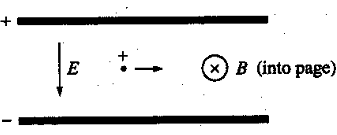 38. As shown, a positively charged
particle moves to the right without deflection through a pair of charged
plates. Between the plates are a uniform electric field E of magnitude 6.0 N/C
and a uniform magnetic field B of magnitude 2.0 T, directed as shown in the
figure. The speed of the particle is most nearly
38. As shown, a positively charged
particle moves to the right without deflection through a pair of charged
plates. Between the plates are a uniform electric field E of magnitude 6.0 N/C
and a uniform magnetic field B of magnitude 2.0 T, directed as shown in the
figure. The speed of the particle is most nearly
(A) 0.33 m/s (B) 0.66 m/s (C) 3.0 m/s (D) 12 m/s (E) 18 m/s
39. Two long, parallel wires, fixed in space, carry currents I1 and I2. The force of attraction has magnitude F. What currents will give an attractive force of magnitude 4F?
(A) 2I1 and ½I2 (B) I1 and ¼I2 (C) ½I1 and ½I2 (D) 2I1 and 2I2 (E) 4I1 and 4I2
40. A charged particle is projected with
its initial velocity parallel to a uniform magnetic field. The resulting path
is
(A) a spiral (B) a parabolic arc (C) a circular arc (D) a straight
line parallel to the field
(E) a straight line perpendicular to the field
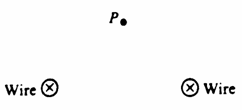
41. Two very long parallel wires carry equal currents in the same direction into the page, as shown. At point P, which is 10 centimeters from each wire, the magnetic field is
A) zero D)
directed to the left
B) directed into the page E) directed to the right
C) directed out of the page
Questions 42‑43
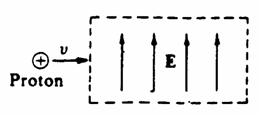 A proton traveling with speed v
enters a uniform electric field of magnitude E, directed parallel to the
plane of the page, as shown in the figure. There is also a magnetic force on
the proton that is in the direction opposite to that of the electric force.
A proton traveling with speed v
enters a uniform electric field of magnitude E, directed parallel to the
plane of the page, as shown in the figure. There is also a magnetic force on
the proton that is in the direction opposite to that of the electric force.
42. Which of the following is a possible direction for the magnetic field?

![]()
43. If e represents the magnitude of the proton charge, what minimum magnitude of the magnetic field could balance the electric force on the proton?
(A) E/v (B) eE/v (C) vE (D) eE (E) evE
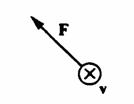 44. In a region of space there is a
uniform B field in the plane of the page but no E field. A
positively charged particle with velocity v directed into the page is
subject to a force F in the plane of the page as shown. Which of the
following vectors best represents the direction of B?
44. In a region of space there is a
uniform B field in the plane of the page but no E field. A
positively charged particle with velocity v directed into the page is
subject to a force F in the plane of the page as shown. Which of the
following vectors best represents the direction of B?
![]()
![]()
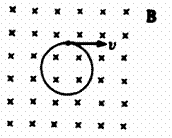 45. A negatively charged particle in a
uniform magnetic field B moves with constant speed v in a circular
path of radius r, as shown. Which of the following graphs best represents the
radius r as a function of the magnitude of B, if the speed v is
constant?
45. A negatively charged particle in a
uniform magnetic field B moves with constant speed v in a circular
path of radius r, as shown. Which of the following graphs best represents the
radius r as a function of the magnitude of B, if the speed v is
constant?

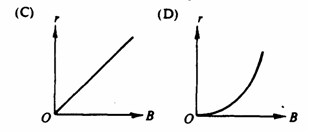
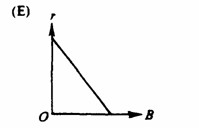
Questions 46-47 relate to the two long parallel wires shown. Initially the wires are a distance d apart and each has a current i directed into the page. The force per unit length on each wire has magnitude Fo
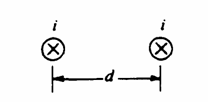
46. The direction of the force on the right‑hand wire due to the current in the left‑hand wire is
(A) to the right (B) to the
left
(C) upward in the plane of the page
(D) downward in the plane of the page (E) into the page
47. The wires are moved apart to a separation 2d and the current in each wire is increased to 2i. The new force per unit length on each wire is
(A) F0/4 (B) Fo/2 (C) Fo (D) 2Fo (E) 4Fo

48. Two identical parallel conducting rings have a common axis and are separated by a distance a, as shown. The two rings each carry a current I, but in opposite directions. At point P, the center of the ring on the left the magnetic field due to these currents is
(A) zero
(B) in the plane perpendicular to the x‑axis
(C) directed in the positive x‑direction
(D) directed in the negative x‑direction
(E) none of the above
49. A square loop of wire 0.3 meter on a side carries a current of 2 amperes and is located in a uniform 0.05‑tesla magnetic field. The left side of the loop is aligned along and attached to a fixed axis. When the plane of the loop is parallel to the magnetic field in the position shown, what is the magnitude of the torque exerted on the loop about the axis?
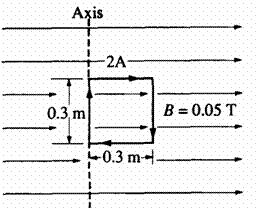 A) 0.00225 Nm
A) 0.00225 Nm
B) 0.0090 Nm
C) 0.278 Nm
D) 1.11 Nm
E) 111 Nm
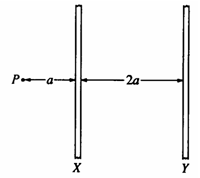 50. Two long parallel wires are a distance
2a apart, as shown. Point P is in the plane of the wires and a distance a
from wire X. When there is a current I in wire X and no current in wire Y, the
magnitude of the magnetic field at P is Bo. When there are equal
currents I in the same direction in both wires, the magnitude of the magnetic
field at P is
50. Two long parallel wires are a distance
2a apart, as shown. Point P is in the plane of the wires and a distance a
from wire X. When there is a current I in wire X and no current in wire Y, the
magnitude of the magnetic field at P is Bo. When there are equal
currents I in the same direction in both wires, the magnitude of the magnetic
field at P is
A) 2Bo/3 B) Bo C) 10Bo/9 D) 4Bo/3 E) 2 Bo
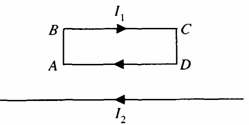 51. A rigid,
rectangular wire loop ABCD carrying current I1 lies in the
plane of the page above a very long wire carrying current I2
as shown. The net force on the loop is
51. A rigid,
rectangular wire loop ABCD carrying current I1 lies in the
plane of the page above a very long wire carrying current I2
as shown. The net force on the loop is
(A) toward
the wire (D) toward the right
(B) away from the wire (E) zero
(C) toward the left
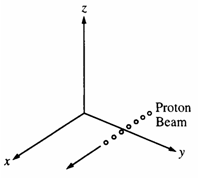
52. A beam of protons moves parallel to the x‑axis in the positive x‑direction, as shown, through a region of crossed electric and magnetic fields balanced for zero deflection of the beam. If the magnetic field is pointed in the positive y‑direction, in what direction must the electric field be pointed?
(A) Positive y‑direction (D) Negative y‑direction
(B) Positive z‑direction (E) Negative z‑direction
(C) Negative x‑direction
53. A charged particle can move with constant velocity through a region containing both an electric field and a magnetic field only if the
(A) electric field is parallel to the magnetic field
(B) electric field is perpendicular to the magnetic field
(C) electric field is parallel to the velocity vector
(D) magnetic field is parallel to the velocity vector
(E) magnetic field is perpendicular to the velocity vector
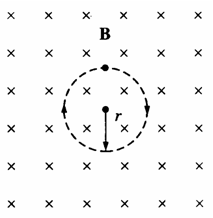 54. A
negatively charged particle in a uniform magnetic field B moves in a circular path
of radius r, as shown. Which of the following graphs best depicts how the
frequency of revolution f of the particle depends on the radius r?
54. A
negatively charged particle in a uniform magnetic field B moves in a circular path
of radius r, as shown. Which of the following graphs best depicts how the
frequency of revolution f of the particle depends on the radius r?
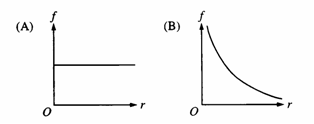

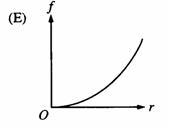
Questions 55-56
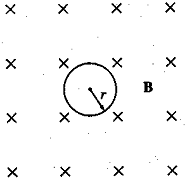
A particle of charge +e and mass m moves with speed v perpendicular to a
uniform magnetic field B directed into the page. The path of the particle is a
circle of radius r, as shown.
55. Which of the following correctly gives the direction of motion and the equation relating v and r ?
Direction Equation
(A) Clockwise eBr = mv
(B) Clockwise eBr = mv2
(C) Counterclockwise eBr = mv
(D) Counterclockwise eBr = mv2
(E) Counterclockwise eBr2 = mv2
56. The period of revolution of the particle is



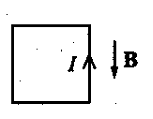
57. A square loop of wire carrying a current I is initially in the plane of the page and is located in a uniform magnetic field B that points toward the bottom of the page, as shown. Which of the following shows the correct initial rotation of the loop due to the force exerted on it by the magnetic field?
![]()
![]()
![]()
![]()
![]()
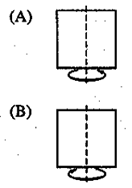
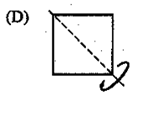

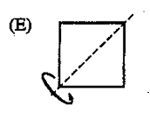

58. The currents in three parallel wires, X, Y, and Z, each have magnitude I and are in the directions shown. Wire y is closer to wire X than to wire z. The magnetic force on wire y is
(A) zero
(B) into the page
(C) out of the page
(D) toward the bottom of the page
(E) toward the left
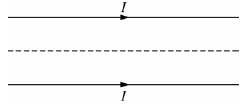 59. Two long,
straight, parallel wires in the plane of the page carry equal currents I in
the same direction, as shown above. Which of the following correctly describes
the forces acting on the wires and the resultant magnetic field at points along
the dotted line midway between the wires?
59. Two long,
straight, parallel wires in the plane of the page carry equal currents I in
the same direction, as shown above. Which of the following correctly describes
the forces acting on the wires and the resultant magnetic field at points along
the dotted line midway between the wires?
Forces Field
(A) Attractive Not zero
(B) Attractive Zero
(C) Zero Zero
(D) Repulsive Not zero
(E) Repulsive Zero
SECTION B – Induction
1. The rate of change of flux has which of
the following units
A) farads B) joules C) volts D) m/s E) webers
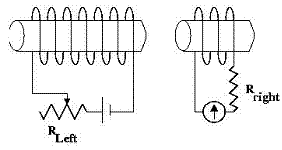 2. For the solenoids shown in the diagram
(which are assumed to be close to each other), the resistance of the left-hand
circuit is slowly increased. In which direction does the ammeter needle
(indicating the direction of conventional current) in the right-hand circuit
deflect in response to this change?
2. For the solenoids shown in the diagram
(which are assumed to be close to each other), the resistance of the left-hand
circuit is slowly increased. In which direction does the ammeter needle
(indicating the direction of conventional current) in the right-hand circuit
deflect in response to this change?
A) The needle deflects to the left.
B) The needle deflects to the right.
C) The needle oscillates back and forth.
D) The needle rotates in counterclockwise circles.
E) The needle never moves.
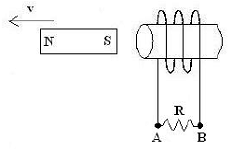
3. A strong bar magnet is held very close to the opening of a solenoid as shown in the diagram. As the magnet is moved away from the solenoid at constant speed, what is the direction of conventional current through the resistor shown and what is the direction of the force on the magnet because of the induced current?
|
|
Current through resistor |
Force on Magnet |
|
A) |
From A to B |
To the left |
|
B) |
From B to A |
To the left |
|
C) |
From A to B |
To the right |
|
D) |
From B to A |
To the right |
|
E) |
No current |
To the righ |
4. A magnet is dropped through a vertical copper pipe slightly larger than the magnet. Relative to the speed it would fall in air, the magnet in the pipe falls.
A) more slowly because it is attracted by the innate magnetic field of the pipe
B) more slowly because the currents
induced in the pipe produce an opposing magnetic field
C) at the same rate
D) more quickly because it is attracted by the innate magnetic field of the
pipe
E) more quickly because the currents induced in the pipe produce an opposing
magnetic field
5. A 0.20 m long copper rod has constant
velocity 0.30 m/s traveling through a uniform magnetic field of 0.060 T. The
rod, velocity, and magnetic field are all mutually perpendicular. What is the
potential difference induced across the rod’s length?
A) 0.0036 V B) 0.040 V C) 0.090 V D) 1.0 V E) 25 V
6. When a wire moving through a magnetic
field has a voltage induced between the wire’s ends, that voltage is
I. directly proportional to the strength of the magnetic field
II. directly proportional to the velocity of the wire
III. directly proportional to the diameter of the wire
A) I only B) II only C) III only D) I and II only E) II and
III only
7. Lenz’s law concerning the direction of
an induced current in a conductor by a magnetic field could be a restatement of
A) Ampere’s law B) Ohm’s Law C)
Tesla’s Law
D) The Law of Conservation of Energy E) none of these
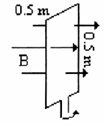 8. A square loop is placed in a uniform
magnetic field perpendicular to the plane of the loop as shown. The loop is
0.50 meters on a side and the magnetic field B has a strength of 2 T. If the
loop is rotated through an angle of 90° in 0.1 second what would be the average
induced EMF in the loop?
8. A square loop is placed in a uniform
magnetic field perpendicular to the plane of the loop as shown. The loop is
0.50 meters on a side and the magnetic field B has a strength of 2 T. If the
loop is rotated through an angle of 90° in 0.1 second what would be the average
induced EMF in the loop?
A) 0.025 C B) 0.40 V C) 5 V D) 10 V E) 80 V

9. The figure shows a bar moving to the
right on two conducting rails. To make an induced current i in the direction
indicated, in what direction would the magnetic field be in the area contained
within the conducting rails?
A) out of the page D) to the left
B) into the page E) It is impossible
C) to the right
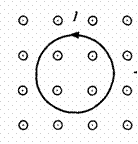
10. There is a counterclockwise current I in a circular loop of wire situated in an external magnetic field directed out of the page as shown. The effect of the forces that act on this current is to make the loop
(A) expand in size
(B) contract in size
(C) rotate about an axis perpendicular to the page
(D) rotate about an axis in the
plane of the page
(E) accelerate into the page
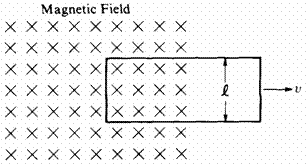 11. The figure shows a rectangular loop of
wire of width l and resistance R. One end of the loop is in a uniform
magnetic field of strength B at right angles to the plane of the loop. The loop
is pulled to the right at a constant speed v. What are the magnitude and
direction of the induced current in the loop?
11. The figure shows a rectangular loop of
wire of width l and resistance R. One end of the loop is in a uniform
magnetic field of strength B at right angles to the plane of the loop. The loop
is pulled to the right at a constant speed v. What are the magnitude and
direction of the induced current in the loop?
Magnitude Direction
(A) BlvR Clockwise
(B) BlvR Counterclockwise
(C) Blv/R Clockwise
(D) Blv/R Counterclockwise
(E) 0 Undefined
12. In each of the following situations, a bar magnet is aligned along the axis of a conducting loop. The magnet and the loop move with the indicated velocities. In which situation will the bar magnet NOT induce a current in the conducting loop?
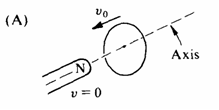
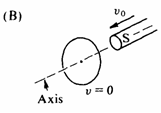
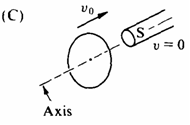
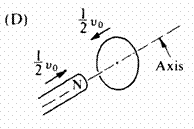
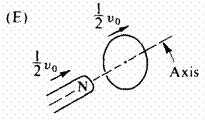
13. A square loop of copper wire is
initially placed perpendicular to the lines of a constant magnetic field of
5 x 10‑3 tesla. The area enclosed by the loop
is 0.2 square meter. The loop is then turned through an angle of 90° so that
the plane of the loop is parallel to the field lines. The turn takes 0.1
second. The average emf induced in the loop during the turn is
(A) 1.0 x 10‑4 V (B) 2.5 x 10‑3
V (C) 0.01 V (D) 100 V (E) 400 V
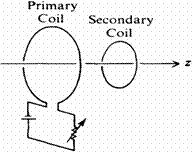
14. Two circular coils are situated
perpendicular to the z‑axis as shown. There is a current in the primary
coil. All of the following procedures will induce a current in the secondary
coil EXCEPT
(A) rotating the secondary coil about the z‑axis
(B) rotating the secondary coil about a diameter
(C) moving the secondary coil closer to the primary coil
(D) varying the current in the primary coil
(E) decreasing the cross‑sectional area of the secondary coil
15. A magnetic field B that is decreasing
with time is directed out of the page and passes through a loop of wire in the
plane of the page, as shown. Which of the following is true of the induced
current in the wire loop?
(A) It is counterclockwise in direction.
(B) It is clockwise in direction.
(C) It is directed into the page.
(D) It is directed out of the page.
(E) It is zero in magnitude.

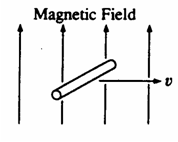 16. A wire of constant length is moving in
a constant magnetic field, as shown. The wire and the velocity vector are
perpendicular to each other and are both perpendicular to the field. Which of
the following graphs best represents the potential difference E between the
ends of the wire as a function of velocity?
16. A wire of constant length is moving in
a constant magnetic field, as shown. The wire and the velocity vector are
perpendicular to each other and are both perpendicular to the field. Which of
the following graphs best represents the potential difference E between the
ends of the wire as a function of velocity?
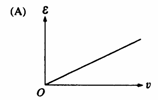

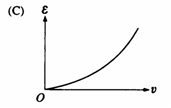
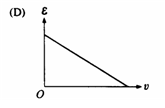
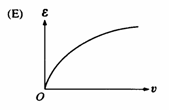
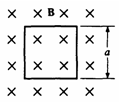
17. A square loop of wire of resistance R
and side a is oriented with its plane perpendicular to a magnetic field B,
as shown. What must be the rate of change of the magnetic field in order to
produce a current I in the loop?
(A) IR/a2 (B) Ia2/R (C) Ia/R
(D) Ra/I (E) IRa
18. A rectangular
wire loop is at rest in a uniform magnetic field B of magnitude 2 T
that is directed out of the page. The loop measures
5 cm by 8 cm, and the plane of the loop is perpendicular to the field, as
shown. The total magnetic flux through the loop is
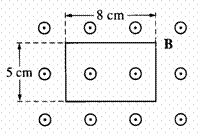 (A) zero (B) 2 x 10‑3
T‑m2 (C) 8 x 10‑3 T-m2
(A) zero (B) 2 x 10‑3
T‑m2 (C) 8 x 10‑3 T-m2
(D) 2 x 10‑1 T-m2 (E) 8 x 10-1
T-m
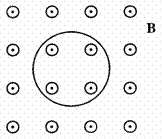 19. A single
circular loop of wire in the plane of the page is perpendicular to a uniform
magnetic field B directed out of the page, as shown. If the magnitude of
the magnetic field is decreasing, then the induced current in the wire is
19. A single
circular loop of wire in the plane of the page is perpendicular to a uniform
magnetic field B directed out of the page, as shown. If the magnitude of
the magnetic field is decreasing, then the induced current in the wire is
(A) directed out of the paper
(B) directed into the paper
(C) clockwise around the loop
(D) counterclockwise around the loop
(E) zero (no current is induced)
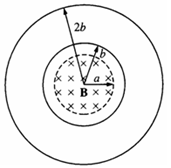
20. A uniform magnetic field B that is perpendicular to the plane of the page now passes through the loops, as shown. The field is confined to a region of radius a, where a < b, and is changing at a constant rate. The induced emf in the wire loop of radius b is e. What is the induced emf in the wire loop of radius 2b ?
(A) Zero (B) e/2 (C) e (D) 2e (E) 4e
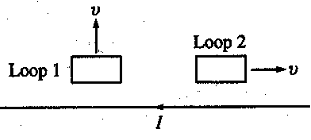 21. Two conducting wire loops move near a
very long, straight conducting wire that carries a current I. When the loops
are in the positions shown, they are moving in the direction shown with the
same constant speed v. Assume that the loops are far enough apart that they do
not affect each other. Which of the following is true about the induced
electric currents, if any, in the loops?
21. Two conducting wire loops move near a
very long, straight conducting wire that carries a current I. When the loops
are in the positions shown, they are moving in the direction shown with the
same constant speed v. Assume that the loops are far enough apart that they do
not affect each other. Which of the following is true about the induced
electric currents, if any, in the loops?
LOOP 1 LOOP 2
(A) No current No current
(B) No current Counterclockwise direction
(C) Clockwise direction No current
(D) Clockwise direction Clockwise direction
(E) Counterclockwise direction Clockwise direction
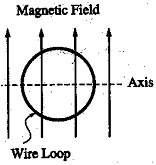
22. A wire loop is rotated in a uniform magnetic field about an axis perpendicular to the field, as shown. How many times is the induced current in the loop reversed if the loop makes 3 complete revolutions from the position shown?
(A) One (B) Two C) Three (D) Six (E) Twelve
Questions 23‑24
 The ends of a metal bar rest on two horizontal north‑south
rails as shown. The bar may slide without friction freely with its length
horizontal and lying east and west as shown. There is a magnetic field parallel
to the rails and directed north.
The ends of a metal bar rest on two horizontal north‑south
rails as shown. The bar may slide without friction freely with its length
horizontal and lying east and west as shown. There is a magnetic field parallel
to the rails and directed north.
23. If the bar is pushed northward on the rails, the electromotive force induced in the bar as a result of the magnetic field will
(A) be directed upward
(B) be zero
(C) produce a westward current
(D) produce an eastward
current
(E) stop the motion of the bar
24. A battery is connected between the
rails and causes the electrons in the bar to drift to the east. The resulting
magnetic force on the bar is directed
(A) north (B) south (C) east (D) west (E) vertically
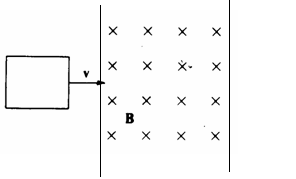 25. A loop of wire is pulled with constant
REGION I REGION II REGION III velocity v to the
right through a region of space where there is a uniform magnetic field B
directed into the page, as shown. The induced current is as follows
25. A loop of wire is pulled with constant
REGION I REGION II REGION III velocity v to the
right through a region of space where there is a uniform magnetic field B
directed into the page, as shown. The induced current is as follows
A) Directed CW both entering and
leaving REGION II.
B) Directed CCW both entering and leaving REGION II.
C) Directed CW entering REGION II and CCW leaving REGION II
D) Directed CCW entering REGION II and CW leaving REGION II.
E) zero at all times
 26. A square loop of wire of side 0.5
meter and resistance 10‑2 ohm is located in a uniform magnetic
field of intensity 0.4 tesla directed out of the page as shown. The magnitude
of the field is decreased to zero at a constant rate in 2 seconds. As the
field is decreased, what are the magnitude and direction of the current in the
loop?
26. A square loop of wire of side 0.5
meter and resistance 10‑2 ohm is located in a uniform magnetic
field of intensity 0.4 tesla directed out of the page as shown. The magnitude
of the field is decreased to zero at a constant rate in 2 seconds. As the
field is decreased, what are the magnitude and direction of the current in the
loop?
(A) Zero
(B) 5 A, counterclockwise
(C) 5 A, clockwise
(D) 20 A, counterclockwise
(E) 20 A, clockwise
Questions 27‑28 refer to the diagram below of two conducting loops having a common axis.
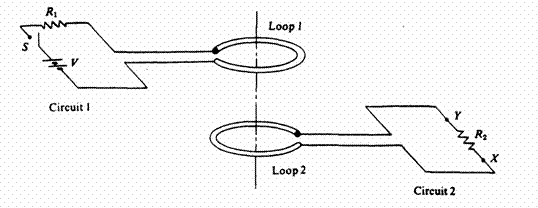
27. After the switch S is closed, the initial current through resistor R2 is
(A) from point X to point Y (B) from point Y to point X (C) zero at all times
(D) oscillating between X and Y (E) impossible to determine its direction
28. After the switch S has been closed for a very long time, the currents in the two circuits are
(A) zero in both circuits (B) zero in circuit 1 and V/R2 in circuit 2
(C) V/R1 in circuit 1 and zero in circuit 2 (D) V/R1 in circuit I and V/R2 in circuit 2
(E) oscillating with constant amplitude in both circuits
29. In the figure, the north pole of the magnet is first moved down toward the loop of wire, then withdrawn upward. As viewed from above, the induced current in the loop is
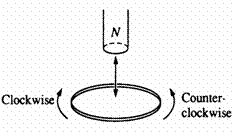 A) always clockwise with
increasing magnitude
A) always clockwise with
increasing magnitude
B) always clockwise with decreasing magnitude
C) always counterclockwise with increasing magnitude
D) always counterclockwise with decreasing magnitude
E) first counterclockwise, then clockwise
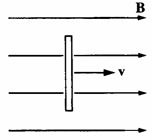 30. A vertical
length of copper wire moves to the right with a steady velocity v in the
direction of a constant horizontal magnetic field B as shown. Which of the
following describes the induced charges on the ends of the wire?
30. A vertical
length of copper wire moves to the right with a steady velocity v in the
direction of a constant horizontal magnetic field B as shown. Which of the
following describes the induced charges on the ends of the wire?
Top End Bottom End
(A) Positive Negative
(B) Negative Positive
(C) Negative Zero
(D) Zero Negative
(E) Zero Zero
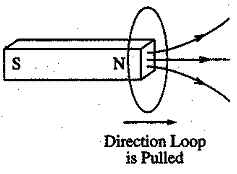 31. A conducting loop of wire that is
initially around a magnet is pulled away from the magnet to the right, as
indicated in the figure, inducing a current in the loop. What is the direction
of the force on the magnet and the direction of the magnetic field at the
center of the loop due to the induced current?
31. A conducting loop of wire that is
initially around a magnet is pulled away from the magnet to the right, as
indicated in the figure, inducing a current in the loop. What is the direction
of the force on the magnet and the direction of the magnetic field at the
center of the loop due to the induced current?
Direction of
Magnetic Field at
Direction of Center of Loop due
Force on the Magnet to Induced Current
(A) To the right To the right
(B) To the right To the left
(C) To the left To the right
(D) To the left To the left
(E) No direction; To the left
the force is zero.
 32. A uniform
magnetic field B is directed out of the page, as shown above. A loop of
wire of area 0.40 m2 is in the plane of the page. At a certain instant
the field has a magnitude of 3.0 T and is decreasing at the rate of 0.50 T/s.
The magnitude of the induced emf in the wire loop at this instant is most
nearly
32. A uniform
magnetic field B is directed out of the page, as shown above. A loop of
wire of area 0.40 m2 is in the plane of the page. At a certain instant
the field has a magnitude of 3.0 T and is decreasing at the rate of 0.50 T/s.
The magnitude of the induced emf in the wire loop at this instant is most
nearly
(A) 0.20 V (B) 0.60 V (C) 1.2 V (D) 1.5 V (E) 2.8 V
Скачано с www.znanio.ru
Материалы на данной страницы взяты из открытых источников либо размещены пользователем в соответствии с договором-офертой сайта. Вы можете сообщить о нарушении.